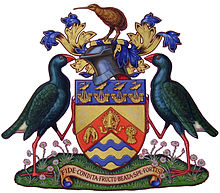- Coat of arms of the City of Christchurch
-
Coat of arms of the City of Christchurch Details Armiger Christchurch City Council Adopted 1949 Crest Kiwi Torse Blue and Gold Escutcheon Four Lymphads, Mitre, Fleece and Garb and two Bars Wavy Supporters Pukeko Compartment Grassy with Celmesia Flowers Motto Latin: Fide Condita Fructu Beata Spe Fortis The Coat of Arms of the City of Christchurch, also known as the armorial bearings, is the official symbol of the City of Christchurch, New Zealand. They were granted to the City by the College of Arms by Letters Patent on February 21, 1949.
Contents
Blazon
Or on a Chevron Gules a Mitre between a Fleece and a Garb of the first in base two Bars wavy Azure on a Chief of the last four Lymphads sails furled, also of the first And for the Crest on a Wreath Or and Azure a Kiwi proper. Supporters On either side a Pukeko proper.[citation needed]
Significance of main features
Arms
The four Lymphads represent the "First Four Ships" (the Charlotte-Jane, the Randolph, the Sir George Seymour and the Cressy) which arrived in 1850 with the first settlers of the area. The Mitre symbolizes that Christchurch was planned as a Church of England settlement and was made a Bishop's See, with City status, by Queen Victoria in 1856. The fleece and garb denote the agricultural and pastoral pursuits of the surrounding region. The two bars wavy represent the two rivers running through the City; the Avon and Heathcote.
Crest
On the blue and gold wreath of the helmet is a Kiwi, a flightless native bird, which is also used as a New Zealand national emblem.
Supporters
The Pukeko (or swamp hen) is a native bird found in and around the Christchurch City area.
Motto
Fide Condita Fructu Beata Spe Fortis translated means "Founded in Faith, Rich in the Fulfillment thereof, Strong in Hope for the Future". Further interpretation can be read:
- "Fide condita" is a reference to ecclesiastical origins and name of the City, taking "fides" in the sense of the Christian Faith.
- "Fructu beata" means "rich in the fruits of the earth" and "rich in the fruits of her industry", as well as in the fulfillment of the Founders' Faith.
- "Spe fortis" means at once "strong in hope" and "bold in her claims upon the future".
References
- Christchurch City Council Handbook How The Council Works, Our History, Coat of Arms.
Categories:- 1949 introductions
- Christchurch culture
- Coats of arms of cities
Wikimedia Foundation. 2010.


